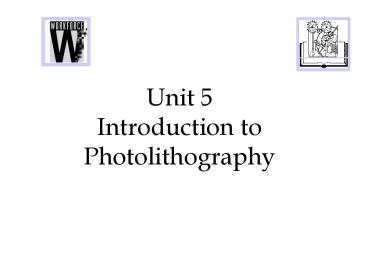Unit 5 Introduction to Photolithography PowerPoint PPT Presentation
1 / 28
Title: Unit 5 Introduction to Photolithography
1
Unit 5 Introduction to Photolithography
2
Introduction to Photolithography
Transistor Layers
p-well
n-well
n-channel transistor
p-channel transistor
p substrate
Julian Serda edited by Roy Stamps
3
Objectives
- Given a multiple choice test, be able to select
the correct answer related to the following
terms, concepts and processes covered in this
lesson - wafer conditions that affect the photo process.
- characteristics of wafers after completion of the
photolithography process. - differences between negative and positive
photolithography processes. - ten basic steps of the photomasking process.
- basic features of each of the ten steps of the
photomasking process.
4
Terms and Concepts to be Covered in this Lesson
- photolithography
- microlithography
- dehydration bake
- hydrophobic
- hexamethyldisilazine
- HMDS
- photoresist
- exposure
- linewidth resolution
- overlay accuracy
- positive lithography
- negative lithography
- windows islands
- adhesion
- film thickness
- light absorbance
- uniformity
- develop
- etch strip
5
Photolithography -- Definitions
- Photolithography is used to produce 3-D images
using light sensitive photoresist and controlled
exposure to light.
- Microlithography is the technique used to print
ultra-miniature patterns -- used primarily in the
semiconductor industry.
6
Photolithography is at the Center of the Wafer
Fabrication Process
7
What else is Photolithography?
- 3-dimensional circuit patterning
- Most critical step in IC process
- Determines feature resolution
- Determines overlay accuracy
- Bottleneck in the fab process
- The leading technology
8
Other Terms used to Describe Photolithography
- masking
- photomasking
- photo
- lithography
- litho
- yellow room
- dark room
9
Wafer Conditions Prior to Patterning
- Surface conditions include
- film composition, e.g. silicon, nitride,
polysilicon, metal, etc. - bare surface vs. patterned surface
- surface reflectivity
- Surface conditions may affect
- photoresist-to-wafer adhesion
- alignment accuracy
- linewidth resolution
- exposure settings
- bake time
10
Wafer Conditions after Photolithography
- resist coated wafer
- patterned resist layer
- withstands etching process
- withstands ion implanting
- quality measures
- linewidth resolution
- overlay accuracy
- particles defects
11
Importance of Resolution and Overlay Registration
contact
12
Types of Photolithography Processes
- Negative Prints a pattern that is opposite of
the pattern that is on the mask. - Positive Prints a pattern that is the same as
the pattern on the mask.
13
Negative Lithography
Areas exposed to light become polymerized and
resist the develop chemical.
Island
Resulting pattern after the resist is developed.
14
Positive Lithography
Areas exposed to light become photosoluble.
Island
Window
oxide
silicon substrate
Resulting pattern after the resist is developed.
15
Ten Basic Steps of Photolithography
1. Surface Preparation 2. Photoresist
Application 3. Soft Bake 4. Align
Expose 5. Develop 6. Hard Bake 7. Develop
Inspection 8. Etch 9. Resist Strip 10. Final
Inspection
Some processes may include a Post-exposure Bake
and Deep UV treatment.
16
1. Surface Preparation (HMDS vapor prime)
- Dehydration bake in enclosed chamber with exhaust
- Clean and dry wafer surface (hydrophobic)
- Hexamethyldisilazane (HMDS)
- Temp 200 - 250C
- Time 60 sec.
17
2. Photoresist Application
- Wafer held onto vacuum chuck
- Dispense 5ml of photoresist
- Slow spin 500 rpm
- Ramp up to 3000 - 5000 rpm
- Quality measures
- time
- speed
- thickness
- uniformity
- particles defects
18
3. Soft Bake
- Partial evaporation of photo-resist solvents
- Improves adhesion
- Improves uniformity
- Improves etch resistance
- Improves linewidth control
- Optimizes light absorbance characteristics of
photoresist
19
4. Alignment and Exposure
UV Light Source
- Transfers the mask image to the resist-coated
wafer - Activates photo-sensitive components of
photoresist - Quality measures
- linewidth resolution
- overlay accuracy
- particles defects
Mask
l
Resist
20
5. Develop
- Soluble areas of photoresist are dissolved by
developer chemical - Visible patterns appear on wafer
- windows
- islands
- Quality measures
- line resolution
- uniformity
- particles defects
21
6. Hard Bake
- Evaporate remaining photoresist
- Improve adhesion
- Higher temperature than soft bake
22
7. Develop Inspect
- Optical or SEM metrology
- Quality issues
- particles
- defects
- critical dimensions
- linewidth resolution
- overlay accuracy
23
8. Etch
- Selective removal of upper layer of wafer through
windows in photoresist - Two basic methods
- wet acid etch
- dry plasma etch
- Quality measures
- defects and particles
- step height
- selectivity
- critical dimensions
24
9. Photoresist Removal (strip)
- No need for photoresist following etch process
- Two common methods
- wet acid strip
- dry plasma strip
- Followed by wet clean to remove remaining resist
and strip byproducts
25
10. Final Inspection
- Photoresist has been completely removed
- Pattern on wafer matches mask pattern (positive
resist) - Quality issues
- defects
- particles
- step height
- critical dimensions
26
Review Ten Basic Steps of Photolithography
- 1. Surface Preparation
- 2. Photoresist Application
- 3. Soft Bake
- 4. Align Expose
- 5. Develop
- 6. Hard Bake
- 7. Develop Inspection
- 8. Etch
- 9. Resist Strip
- 10. Final Inspection
Some processes may include a Post-exposure Bake
and Deep UV treatment.
27
Label the 10 Basic Steps of Photolithography
28
Number and Label 10 Basic Steps of
Photolithography

